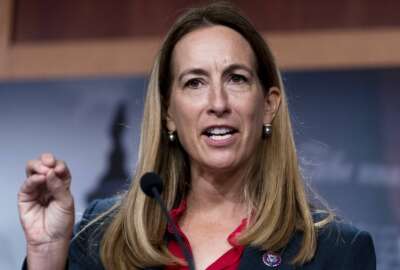Pentagon starts 45-day countdown to civilian furloughs
The Pentagon says furloughs for nearly all of its 780,000 civilian employees would begin in April if sequestration goes into effect. DoD would grant limited...
In its latest acknowledgement that sequestration now appears more likely than not, the Pentagon Wednesday sent Congress its official notification that it plans to furlough the vast majority of its civilian workforce in the second half of fiscal 2013.
The legally-required notification to lawmakers starts a 45-day clock before the Pentagon can begin imposing furloughs on its 780,000 civil servants. Actual furloughs would not begin until late April, said Robert Hale, the Pentagon’s comptroller, and only will happen if Congress leaves sequestration on the books, forcing DoD to scrounge for any dollar it can find in its operation and maintenance accounts.
“This is one of the most distasteful tasks I have faced in my four years in this job,” Hale told reporters Wednesday. “We feel we don’t have any choice but to impose furloughs, even though we’d much prefer not to do it. We’re more than 20 percent short in operations and maintenance with seven months to go [in the fiscal year]. We can’t do reductions in force, especially at this point in the year. RIFs would cost us money because of unused leave and severance pay, so furloughs are really the only way we have to quickly cut civilian personnel funding.”
The Pentagon said the furloughs will save it between $4-$5 billion in the current fiscal year — just a fraction of the $46 billion cut it would have to make up for if sequestration stays in effect.
A document officials distributed to reporters offers a state-by-state breakdown, estimating the local impacts the unpaid furloughs would have across the country in the remainder of 2013. Virginia tops the list with an estimated $661 million in reduced DoD payrolls. California is next at $420 million, followed by Maryland at $359 million.
Every service and agency will be affected
Furloughed employees would be told to stay home one day per week without pay between April and Sept. 30. If DoD has to implement unpaid leave, the Pentagon wants the furloughs to be spread equitably across every military branch and defense agency, though there will be civilian employees who will be declared exempt.
Those exemptions, Hale said, will be granted sparingly. But civilians deployed in combat zones will be declared off-limits, as will civilians who are required to “maintain the safety of life and/or property.”
“But that’s only to the extent that they have to do that,” Hale said. “In other words, if there are 20 policemen on a base, they aren’t all automatically exempted from furloughs. It’s only to the extent that commanders and managers determine they have to exempt some or all of them.”
Also, employees whose salaries are paid from non-appropriated funds are in the clear, as are foreign nationals working overseas, since their employment status is often complicated by status of forces agreements with foreign governments.
Hale noted, with some regret, that his own job is also safe from furlough.
“It’s slightly embarrassing, but it’s true. Political employees are exempt, by law,” he said.
For the most part, furloughed employees shouldn’t see any impact to benefits such as retirement, life insurance or health insurance, said Jessica Wright, the acting undersecretary of Defense for personnel and readiness.
Trickledown effect of unpaid leave
But, she said the lost wages and the loss of civilian employees’ services will take a severe toll on the military, local economies and individual DoD employees, whether they’re in uniform or not.
“The effects of sequestration and the continuing resolution on our military personnel will be devastating, but on our civilians, it will be catastrophic,” she said. “These critical members of our workforce, they work in our depots, they maintain and repair our tanks, our aircrafts, our ships. They teach our kids, they care for our children. They provide medical treatment to all of our beneficiaries. They take care of our wounded warriors. They provide services and programs such as sexual assault prevention and suicide prevention, just to name a few. The first, the second, and the third-order effects of sequestration will be felt in local commands and local communities all over the United States and, clearly, all over the globe. This is not a Beltway phenomenon.”
Now that DoD has made its notification to Congress, it’s telling the military services to begin identifying employees who should be exempted from furlough. At some point in mid-March, Defense civilians will get letters telling them that they can expect to be furloughed. Thirty days later, they’ll receive notification that they’re going to be furloughed, and will then have one week to appeal the decision to the Merit Systems Protection Board.
Wright said even though DoD has laid out its plan to Congress, it’s still working through tough decisions about furloughs as it tries to prioritize the services civilians provide and soften the impacts in the most crucial areas.
“Our goal is to preserve the accreditation of our schools and ensure quality education for all of our kids. Regarding health care, about 40 percent of our medical providers are civilians. This furlough, if impacted, will affect them greatly. But the department’s intent and our goal is to mitigate that impact and provide quality care and access of care. We’re thoughtfully working through that process now,” she said. “And certainly, family members will feel the impact of this sequestration. While it’s our intent to ease the impact of sequestration on family programs, it is clearly possible that operating hours of commissaries will be curtailed. And while it is our intent to preserve family programs to the greatest extent possible, some family programs may be affected if the length of sequestration goes long and hard.”
Morale a major concern
But Hale said no matter how much the department prioritizes, there will be impacts to the missions of the military services. DoD already has told Congress, it will have to cut training for military personnel because of the same operation and maintenance shortfall. The cutbacks in the services civilians provide will only worsen that problem, he said.
He also said he worries about a continual chipping away at morale, both in the civilian and uniformed ranks.
“Our personnel are committed to carrying out a mission to defend the United States, and I think one thing you’re going to see is a great deal of frustration, because they will see they can’t train as much as they feel they need to and that the readiness of their units is degraded,” he said. “If they’re dealing with investments, they’ll see disruption on all the programs they’re managing. So there will be some aspects of daily life that will be affected, but I think that their satisfaction with the mission is going to be adversely affected, and that’s important to these people, both our civilians and our military.”
There’s no progress on Capitol Hill at the moment toward averting sequestration. Several members of Congress have suggested that a fallback plan might be to at least allow the Pentagon to prioritize its own budget cuts as an alternative to the across-the-board slicing that sequestration requires.
Reprogramming authority not helpful
But Hale said at this point in fiscal 2013, reprogramming authority wouldn’t provide as much help as it would seem.
“For every dollar you add, you have to cut somewhere else. And especially in an environment like this one, where we’ve seen sequestration cuts in the investment accounts, I don’t think there are a lot of good sources,” he said. “And moreover, you’ve got to get essentially every member of Congress to agree to this, or at least all the committees, so it can’t be anything contentious. I’ve had four years of experience with reprogramming and it’s not realistic that we could move multiple billions. We are doing worst-case planning right now. But if the [continuing resolution] stays in effect and sequestration goes into effect for the whole year, I think we’re going to see serious effects. I am worried.”
The Pentagon has not yet finished a detailed plan for how it would handle contracts should sequestration occur. Those contracts cover not just weapons system acquisitions, but also the hundreds of thousands of personnel DoD employs indirectly through service contracts.
“We are developing plans with increasing levels of detail for what we would buy from the private sector in the process of looking at all of our investment programs — 2,500 of them, it takes a lot of work — to figure out what we won’t do in order to accommodate sequestration cuts, and similarly in the service contract area. I think we will be ready for sequestration, if we have to, by March 1,” Hale said. “Under the law, we owe a detailed spend plan by April 1, and that would give more fidelity on exactly the changes. But in terms of managing the workforce, that’s really something that will be done by the private companies.”
RELATED STORIES: DoD details furloughs under sequestration
Navy, Air Force CMOs decry ‘blunt, formulaic’ cuts to civilian workforce
Military issues dire warnings of readiness crisis, decries political gridlock
Copyright © 2025 Federal News Network. All rights reserved. This website is not intended for users located within the European Economic Area.
Jared Serbu is deputy editor of Federal News Network and reports on the Defense Department’s contracting, legislative, workforce and IT issues.
Follow @jserbuWFED






